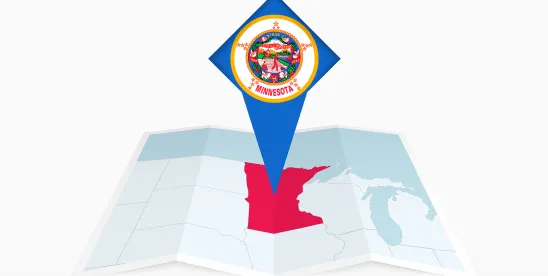Lawmakers in the Land of 10,000 Lakes kept busy this year, enacting and amending a variety of laws affecting Minnesota employers, some of which are already in effect.
This Insight summarizes what’s new and what Minnesota employers must do to comply.
Leave and Time Off
Pregnancy and Parental Leave Expanded
On May 17, 2024, Governor Tim Walz signed a bill amending several provisions of the Minnesota Statutes chapter on employment law, including the law requiring pregnancy accommodations and the Minnesota Pregnancy and Parenting Leave Law (PPL), which guarantees employees up to 12 weeks of unpaid, protected leave in conjunction with the birth or adoption of their child and for prenatal care and health conditions related to pregnancy. The amendments were part of the 2024 Omnibus Labor and Industry Policy Bill (“the 2024 Omnibus Bill”) (S.F. 3852, sections 9 through 11) and, as discussed below, significantly broadened employee entitlements and employer obligations.
First, under one amendment that became effective August 1, 2024, employers may no longer deduct time taken off for prenatal care against an employee’s leave entitlement under the PPL. This may have the practical effect of allowing employees to use more than 12 weeks of protected leave for pregnancy-related conditions despite the provision capping protected unpaid leave under the PPL.[1]
Second, effective August 1, 2024, instead of merely making coverage available, Minnesota employers must now maintain coverage under any group insurance policy, group subscriber contract, or health care plan for the employee and any dependents as if the employee was not on leave, provided the employee continues to pay any employee share of the cost of the benefits. It remains to be seen if this provision mandating employer continuation of health care coverage will be challenged as preempted by the Employee Retirement Income Security Act (ERISA).
Pregnancy Accommodations
The 2024 Omnibus Bill similarly amended Minnesota’s pregnancy accommodations law to require employers to continue group health benefits for employees with the same benefits coverage and employer contribution as if the employees were not on leave during any leave taken as a pregnancy accommodation.
Paid Sick and Safe Leave Clarified
Enacted last year and effective January 1, 2024, Minnesota’s Earned Sick and Safe Time Law (ESST) requires all Minnesota employers to provide paid sick and safe time to eligible employees working in the state. In brief, employees who work at least 80 hours per year for Minnesota are entitled to earn at least one hour of earned sick and safe time for every 30 hours worked, up to a maximum of 48 hours per year, unless the employer chooses to have a higher cap. Unused sick and safe time may be carried over, subject to an 80-hour total accrual cap. Alternatively, employers may opt to frontload either (i) 48 hours at the beginning of each year, in which case all unused sick and safe time must be paid out to employees at the end of the year, or (ii) 80 hours at the beginning of each year, in which case unused sick and safe time need not be paid out or carried over to the following year.
The ESST allows employees to use accrued paid leave for a variety of reasons, described in detail here by the Minnesota Department of Labor and Industry (DLI).
A follow-up bill (H.F. 5247) enacted this year (“the 2024 Amendments”) clarifies that sick and safe time must be paid at the same “base rate” an employee earns when working and that in no case may such rate be lower than the applicable minimum wage. As explained in guidance published by DLI, the mandatory base rate of pay for leave taken under the ESST is as follows:
- Employees paid on an hourly basis: The base rate is the same hourly rate the employee would have earned had they not taken leave. It does not include overtime pay, shift differentials, holiday pay, gratuities, or commissions. However, if an employee is entitled to varying rates, that employee should be compensated at the same rate that would have been earned during the period when leave was taken.
- Non-exempt employees paid by an annual salary: The base rate of pay must be the employee’s regular pay. The statute expressly provides that exempt employees are deemed to work 40 hours per workweek unless their normal hours are less than 40 hours per week.
- Employees paid by any other basis: The base rate for workers who are paid solely on piecework, commission, or other such method must be at least equivalent to the highest applicable minimum wage.
The 2024 Amendments also expanded benefits to permit employees to use earned sick and safe time “to make arrangements for or to attend funeral services or a memorial or address financial or legal matters that arise after the death of a family member.” Further, the bill modified the increments an employer may impose for employees’ use of earned sick and safe time. Specifically, employees must be permitted to use sick and safe time in the same increments for which they are paid; however, employers need not allow use of sick and safe time in increments smaller than 15 minutes and may not require use in increments greater than four hours.
Another significant change is in how the ESST applies to paid time off (PTO) programs. For employers that choose to have a single, umbrella PTO policy that covers its ESST obligations, all PTO provided in excess of the minimum required amount of sick and safe time must meet or exceed the minimum standards and requirements of the ESST, except for the ESST’s requirements as to the carryover and payout of unused leave at the end of the year. In other words, employers may not have one set of rules and procedures that apply to the use of PTO for ESST purposes and another set of rules for PTO taken for other reasons. This change becomes effective on January 1, 2025. The amendments to the ESST also:
- clarify that an employer’s ability to require reasonable documentation for ESST usage of more than three consecutive days applies only if those three days are scheduled workdays;
- add recordkeeping requirements, including notification to employees at the end of each pay period about their safe and sick time accruals and usage, which may be provided electronically; and
- extend the record-keeping and notification requirements starting on January 1, 2025.
Cities React to the ESST
Of note, several Minnesota municipalities already had paid sick leave laws and responded to the ESST’s enactment as follows:
- St. Paul amended its ordinance to better align with the ESST, particularly as to definitions, and posted updated guidance explaining that “employers are responsible for following the ESST requirements most favorable to their employees. In other words, employers must comply with the specific requirements of the state ESST and the applicable local ESST ordinance that are most favorable to their employees. This may mean following some of the requirements of state ESST and other requirements of the local ESST.”
- Bloomington similarly amended its sick leave ordinance to align with the ESST.
- Duluth repealed its sick leave ordinance on December 18, 2023.
- Minneapolis issued revised Frequently Asked Questions (FAQs) in June 2024 regarding its ordinance but, to date, has not amended its law.
New Family and Medical Leave Program
Starting January 1, 2026, the Paid Leave Law, which was signed into law in 2023, will provide eligible Minnesota employees with job-protected leave and partial wage replacement benefits for qualifying family and medical absences lasting seven days or longer. The law will provide employees with up to 12 weeks of paid leave in a benefit year:
- to care for a family member with a serious health condition,
- to bond with a new baby or child in their family,
- to support a family member called to active duty,
- when the employee or a family member faces a significant personal safety issue, or
- when the employee’s own serious health condition or pregnancy prevents them from working.
Employees will be permitted to take a combined maximum of 20 weeks of paid family leave and paid medical leave in a benefit year.
With limited exceptions, all employees who have earned at least 5.3 percent of the statewide average annual wage will be eligible for paid leave, regardless of employer size. The law excludes certain seasonal workers in the hospitality industry and federal employees, as well as independent contractors and self-employed individuals. Whether protected leave without pay will be available to employees under the income threshold is unclear. The Minnesota Department of Employment and Economic Development (DEED) has indicated that the agency will evaluate this issue and address it in future guidance.
Generally, the paid leave program’s funding will be derived from both employers and employees through premiums based on quarterly wages paid at a rate to be determined by DEED. Employers must submit initial premiums by April 30, 2026, and may begin deducting employee shares of the premium from payroll on January 1, 2026, according to DEED’s FAQs about the program. Small employers (i.e., those with 30 or fewer employees and less than $3 million in gross annual revenues) may be eligible for assistance grants from DEED.
Employers will also be responsible for providing detailed wage reports to the state on a quarterly basis. Importantly, the first deadline for such reports is fast approaching: all Minnesota employers will need to submit a report regarding wages paid during the third quarter of this year by October 31, 2024. Instructions and links to the state’s reporting portal are available on the Unemployment Insurance Minnesota website.
DEED is expected to publish a second draft of proposed rules, which will be open to public comment, sometime this fall.
Wage and Hour
Statewide Pay Disclosure Mandates
Minnesota has joined the wave of pay transparency laws sweeping across the nation, which we discussed in detail here. Pursuant to legislation taking effect on January 1, 2025, Minnesota employers with 30 or more employees in the state will need to include the starting minimum and maximum annual salary or hourly range of compensation and a general description of available employee benefits in job postings. Minnesota defines “job postings” as any solicitation intended to recruit job applicants for a specific available position, including solicitations made indirectly via a third party.
Two-Tiered Minimum Wage System Eliminated
Effective January 1, 2025, the state’s minimum wage system will change. Minnesota currently uses a two-tiered minimum wage system, mandating one minimum wage rate for large employers and a second, lower rate for small employers, which is also the minimum wage rate permitted for minors, certain newly hired employees, and certain employees with visas. The 2024 Omnibus Bill eliminates the lower minimum wage tier and establishes a single minimum wage at the large employer rate. Thus, the bill eliminates the lower minimum wage for small employers, employees under 18 years old, and employees on J visas in the hospitality industry. One exception will remain, however: a lower rate will be permitted for employees under age 20 during their first 90 consecutive days of employment in Minnesota.
Higher Annual Minimum Wage Increases
Minnesota adjusts minimum wage rates annually based on changes to the Consumer Price Index but limits how much the minimum wage rates may increase. Currently, Minnesota allows minimum wage rates to increase up to 2.5 percent annually. Under the 2024 Omnibus Bill, the state will allow minimum wage rates to increase up to 5 percent annually starting on January 1, 2025.
Gratuities and Tips Compensation
Acknowledging the emergence of technologies that allow new electronic payment methods, Minnesota added new tip and gratuity requirements for employers. Effective August 1, 2024, a provision in the 2024 Omnibus Bill requires employers to (1) credit the full amount of any tips received through credit cards or electronic payments to the pay period in which they are received by the employee, and (2) pay the full amount of such tips to employees by the next scheduled pay period.[2] As a result of this change, employers may no longer deduct a credit card swipe fee or other interchange fees from payments for tips before remitting tips to workers. The 2024 Omnibus Bill also added general record-keeping requirements for employers to retain earnings statements or pay stubs for three years.
Protected Classes and Definition of Discrimination Expanded
On May 15, 2024, Governor Tim Walz signed H.F. 4109, broadening the Minnesota Human Rights Act (MHRA). The amendment, which took effect on August 1, 2024, adds the phrase “one or more of the following” to the statute, thus providing that the MHRA prohibits employment discrimination based on one or more of 13 enumerated protected classes. The amendment also broadens the definition of “discriminate” under the MHRA to include harassment on the basis of any protected class, as opposed to limiting that term to encompass harassment only on the basis of sex. The MHRA’s disability protections will now also cover people with episodic disabilities or who are in remission from a disability that would materially limit a major life activity when active. Further, the legislation expands the definition of the “familial status” protected class. Instead of being determined by minors “being domiciled” with a parent or guardian, the definition now determines “familial status” according to “legal status or custody” and further provides that protected familial status includes “residing with and caring for” individuals who cannot care for themselves because they “are unable to receive and evaluate information or make or communicate decisions.”
The amendment increased an employer’s potential exposure under the MHRA. In addition to a doubling of the statute of limitations for a claimant to bring a civil action against an employer after administrative remedies have been exhausted (from 45 to 90 days), civil penalties are now mandatory if a court determines that an employer violated the MHRA. Under the new law, courts will be required to award treble damages (i.e., triple the amount actually lost) in compensatory damages, including mental anguish or suffering, and may also award punitive damages. Additionally, the law provides that, in cases decided by a jury, the jury will determine the amount of all damage awards.
Employee Misclassification and Penalties
In addition to modifying the ESST (discussed above), the 2024 Amendments amended a statute prohibiting the misclassification of employees as independent contractors. The amendment adds a list of “prohibited activities related to employment status” and now provides for compensatory damages to a misclassified worker along with civil penalties. In addition, the Minnesota DLI is empowered to issue stop-work orders for violations and to share investigation information with other state agencies.
Of note, the amendment imposes stringent classification requirements on the construction industry. Construction companies must now satisfy a 14-point test to prove they did not misclassify an employee as an independent contractor. If any of the 14 factors are not satisfied, the worker will be deemed an employee. To enforce these new provisions, the Minnesota DLI may issue stop-work orders for violations and share investigation information with other state agencies.
Employee Drug Testing
Oral Fluid Drug Testing
Lastly, under Article 7, Sections 4-8 of the 2024 Omnibus Bill, employers that are otherwise authorized to conduct screening for cannabis and or alcohol are permitted to use oral fluid testing to screen employees or applicants for drugs or alcohol, including cannabis. Laboratory testing is not required. However, in the event that an oral fluid test indicates a positive, inconclusive, or invalid result, an employee or job applicant may request further testing by a laboratory and may not be required to pay the costs of using such services. If lab results are positive, employees and applicants are entitled to retest, but at their own expense. Note that Minnesota law continues to prohibit (1) requesting or requiring job applicants to undergo cannabis testing as a condition of employment unless the position for which the applicant has applied qualifies for a statutory exemption, and (2) drug or alcohol testing of employees or job applicants unless the employer maintains a written drug and alcohol policy that complies with state law.
What Minnesota Employers Should Do Now
Changes in the state’s employment laws carry substantial effects on employment policies and procedures. Minnesota has increased the DLI’s power to investigate and remedy complaints. To ensure compliance for 2024 and the future, all employers with a Minnesota workforce should do the following soon:
- Review, revise, and update employee handbooks.
- Check company policies and procedures to ensure compliance with state leave and accommodation laws, especially as to paid sick and safe leave and pregnancy accommodation.
- Prepare to disclose wage and benefits information in job postings starting in 2025 if you employ 30 or more individuals.
- Train human resources managers and others regarding changes to policy and procedures necessitated by changes in state and/or local laws.
- Ensure compliance with minimum wage laws in accordance with changes across the state, recalling that higher wages may apply in certain municipalities.
- Prepare to submit a quarterly wage report by October 31, 2024, as required by the new paid leave program.
- Start planning for and ensure compliance with pending employment laws that are not yet in effect.
ENDNOTE
[1] Note that Minnesota employees may be entitled to time off for prenatal care under other laws as well, including, but not limited to, the Family and Medical Leave Act, the Pregnant Workers Fairness Act, the Americans with Disabilities Act, Minnesota’s pregnancy accommodations law, Minnesota’s Earned Sick and Safe Time Law, and any applicable local sick leave laws.






 />i
/>i

